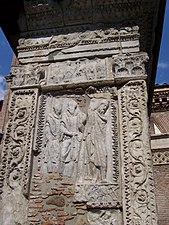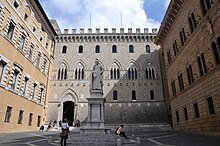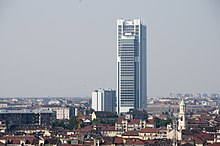
The Bank of Italy is the Italian member of the Eurosystem and has been the monetary authority for Italy from 1893 to 1998, issuing the Italian lira. Since 2014, it has also been Italy's national competent authority within European Banking Supervision. It is located in Palazzo Koch, via Nazionale, Rome.
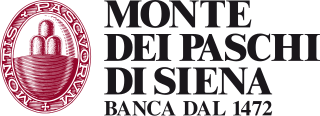
Banca Monte dei Paschi di Siena S.p.A., known as BMPS or just MPS, is an Italian bank. Tracing its history to a mount of piety founded in 1472 and established in its present form in 1624, it is the world's oldest or second oldest bank, depending on the definition, and the fifth largest Italian commercial and retail bank.

Banca Antonveneta S.p.A. was an Italian bank based in Padua, Italy. The bank was absorbed into Banca Monte dei Paschi di Siena in 2013.
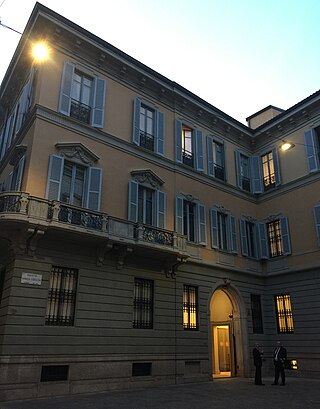
Mediobanca is an Italian investment bank founded in 1946 at the initiative of Raffaele Mattioli and Enrico Cuccia to facilitate the post-World War II reconstruction of Italian industry. Cuccia led Mediobanca from 1946 to 1982. Today, it is an international banking group with offices in Milan, Frankfurt, London, Madrid, Luxembourg, New York and Paris.

UniCredit S.p.A. is an Italian multinational banking group headquartered in Milan. It is a systemically important bank and the world's 34th largest by assets. It was formed through the merger of Credito Italiano and Unicredito in 1998 but has a corporate identity stretching back to its first foundation in 1870 as Banca di Genova. UniCredit is listed on the Borsa Italiana and Frankfurt Stock Exchange and is a constituent stock of the Euro Stoxx 50 index of leading shares.

Banca Nazionale del Lavoro S.p.A. (BNL) is an Italian bank headquartered in Rome. It is Italy's sixth largest bank, and has been a subsidiary of BNP Paribas since 2006. Integration process was concluded in 2008, BNL with its group oversees the commercial banking activity in Italy.

Intesa Sanpaolo S.p.A. is an Italian international banking group. It is Italy's largest bank by total assets and the world's 27th largest. It was formed through the merger of Banca Intesa and Sanpaolo IMI in 2007, but has a corporate identity stretching back to its first foundation as Istituto Bancario San Paolo di Torino in 1583.

Credito Italiano, often referred to by the shorthand Credit, was a significant Italian bank based in Milan. It was established in 1895, succeeding the Banca di Genova established in 1870 in Genoa. In 1998 it merged with Unicredito to form Unicredito Italiano, later known as UniCredit.
The Banca Ifis S.p.A. Group is an Italian finance company that specialises in lending services to undertakings, and acquiring/servicing non-performing loan portfolios.

Crédit Agricole Italia S.p.A., formerly Crédit Agricole Cariparma S.p.A., is an Italian banking group, a subsidiary of French banking group Crédit Agricole. Crédit Agricole Italia was ranked as the 11th largest bank in Italy by total assets at 31 December 2015. The group serving Emilia-Romagna, Liguria and Friuli-Venezia Giulia, where the predecessors originated, as well as Campania, Lazio, Lombardy, Piedmont, Tuscany, Umbria and Veneto, or half of Italian regions.
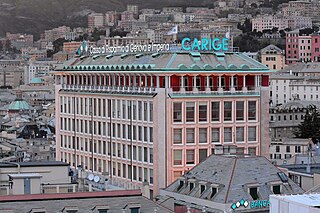
Banca Carige S.p.A., historically known as Cassa di Risparmio di Genova e Imperia (Ca.Ri.Ge.) was an Italian bank based in Genoa, with more than 500 bank branches in Italy, prior to its acquisition by BPER Banca in February 2022. The predecessor of the bank, a mount of piety, was founded in 1483 in Genoa, the Republic of Genoa. Banca Carige and its subsidiaries were known as Banca Carige Group. The banking group was one of the large banking groups in Italy, and as such, was supervised by the European Central Bank. In 2017, the banking group had 529 branches throughout Italy, with one branch in Nice, France, about 37.2% of branches were located in the home region Liguria. In November 2022, Banca Carige was fully incorporated into BPER Banca and ceased to exist as a separate entity.

Banca Popolare di Vicenza (BPVi) was an Italian bank and currently a winding-down company. The banking group along was the 15th-largest retail and corporate bank of Italy by total assets at 31 December 2016, according to Mediobanca. However, its sister bank Veneto Banca also ranked 16th in the same ranking, making the whole banking group that under Atlante, had a higher pro-forma total assets than 10th of the same ranking, Crédit Agricole Italia. Due to its size, BPVi and Veneto Banca were both supervised by the European Central Bank directly, instead of the Bank of Italy.
Cassa di Risparmio di San Miniato S.p.A. (Carismi) was an Italian savings bank based in San Miniato, in the Province of Pisa, Tuscany. It was taken over by Crédit Agricole via its Crédit Agricole Italia division.

Banca di Credito Cooperativo di Cambiano (Castelfiorentino–Firenze) S.C.p.A. known as Banca di Cambiano is an Italian bank based in Castelfiorentino, Tuscany region. The bank served the Tuscan provinces of Florence, Pisa, Siena, Pistoia and Arezzo. The bank was a cooperative bank.
Atlante is an Italian banking sector owned bail-out equity fund that is dedicated to recapitalize some Italian banks, as well as purchase the securities of the junior tranches of non-performing loans. It was established in 2015 in response to the Italian bad debt crisis of that year. The fund was under regulation by the EU Alternative Investment Fund Managers Directive.

Fondazione Monte dei Paschi di Siena (FMPS) is a philanthropic organization based in Siena, Tuscany, Italy. The foundation was in fact the original statutory corporation of Monte dei Paschi di Siena. Due to Legge Amato, in 1995 there was a separation: Banca Monte dei Paschi di Siena became the company controlling the banking business, meanwhile the statutory corporation became Fondazione MPS, a foundation and private legal person which held the bank's shares.

Banco BPM S.p.A. is an Italian bank that started to operate on 1 January 2017, by the merger of Banco Popolare and Banca Popolare di Milano (BPM). The bank is the third largest retail and corporate banking conglomerate in Italy, behind Intesa Sanpaolo and UniCredit. The bank had dual headquarters in Verona and Milan respectively.
Fondazione Roma formerly Fondazione Cassa di Risparmio di Roma is a charity organization based in Rome, Italy. The organization succeeds the historical financial institution Cassa di Risparmio di Roma as it was reorganized as a banking foundation in 1991, with its banking operations spun off to merge with other Roman banks and form Banca di Roma, later a component of Capitalia then Unicredit. The foundation remained as a shareholder of UniCredit, the banking group that acquired Capitalia in mid-2007. As at 31 December 2006, the foundation was the second largest shareholder of Capitalia for 5.02% stake.
In ancient Rome there were a variety of officials tasked with banking. These were the argentarii, mensarii, coactores, and nummulari. The argentarii were money changers. The role of the mensarii was to help people through economic hardships, the coactores were hired to collect money and give it to their employer, and the nummulari minted and tested currency. They offered credit systems and loans. Between 260 and the fourth century CE, Roman bankers disappear from the historical record, likely because of economic difficulties caused by the debasement of the currency.

